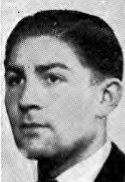

|
|
|
|
|
|
List
Limburg 1940-1945,
Main Menu
The fallen resistance people in Limburg
Pieter “Leij” Merlijn
(Pieter Lambertus)
∗ 31-12-1920 Ede † 12-03-1945 Amsterdam (24)
- Knokploegen (K.P.) - Limburg + - Nijmegen -
- https://www.oorlogsdodennijmegen.nl/persoon/merlijn/d8615d02-4921-4c3b-b858-549cebbdfe1b
- Het Grote Gebod, 1/2, De landelijke knokploegen, Kampen 1951, p. 590
- Monument De Gevallen Hoornblazer Amsterdam
- Mausoleum op de Paasberg, Ede
- Wikipedia NL: Nederlandse Landwacht
- Oorlogsgravenstichting.nl
- Wikipedia NL: Groep 2000
Pieter was a machine fitter [6] and he was a member of the Knokploeg (combat group) in Nijmegen. He participated in raids on distribution offices, in attempts to liberate imprisoned resistance fighters, etc. After the liberation of Nijmegen, he shifted his operational focus to the still occupied western part of the country [1]. Arrested on February 21, 1945 in Hoorn by members of the Landwacht (translated: rural guards, an auxiliary police composed of Dutch fascists) [5], during a food transport [1][2]. The description of the monument "De Gevallen Hoornblazer" [3] in Amsterdam states the following: It
is a tribute to the 30 political prisoners who were executed here on March 12, 1945, in retaliation by the occupying forces.
On March 10, 1945, the SD (Security Service) raided a building on the Stadhouderskade in Amsterdam. This was the headquarters of Groep 2000 [7], a resistance group founded by Jacoba van Tongeren. All members of the group had a code number, which was entered in an encrypted register. The key to the register was buried in the garden of the building. To prevent the occupiers from finding the key, some members of the resistance broke into the building on March 11, 1945. A firefight ensued, during which SS-Hauptscharführer Ernst Wehner (Kriminaloberassistent of the Einsatzkommando Amsterdam) was killed.
In retaliation, the next day 30 prisoners were taken from the prison to the park "Eerste Weteringplantsoen", located opposite the building. The prisoners were executed with three volleys in front of hundreds of Amsterdam citizens who were forced to watch by the occupiers. The clergyman Dr. J. Koopman, who lived on Stadhouderskade, was also shot as he watched from his house. The remains had to stay there as a warning for a long time before they were taken away on an open truck.
On December 31, 2014, his ashes were scattered at the cemetery Mausoleum op de Paasberg in Ede. [4]
Footnotes

